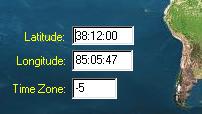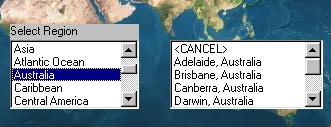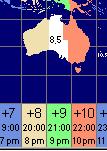
The true power or Radio-Jupiter Pro lies in its ability to make predictions based upon your geographic location and time coordinates.
From the main page select Observer from either the shortcut buttons or the menu at the top of the screen. You will be presented with a world map. Three important parameters are to be decided from this screen:

If you know your coordinates and time zone you can simply type them in here. Alternately you can click the cities button and you will be presented with two list boxes on the map:

First select a region from the list on the left. This fills the list on the right with a list of cities from that region. Click on your city (if it appears) and the latitude and longitude will be automatically placed in the appropriate text boxes. Finally, you can simply point to your location on the map and right click. Note as you move the mouse around the latitude and longitude under the pointer appear in the upper left hand corner.
 These values are only transferred to the text boxes when the mouse is right
clicked.
These values are only transferred to the text boxes when the mouse is right
clicked.
The time zone is not automatically populated by any of the above actions. The zone is important because it relates your local time (the one your computer is set to), to Universal Time or GMT. Calculations of the planetary coordinates are based on GMT in this program, so if you get your time wrong, all of your predictions will be wrong! The time zone is measured in hours (some time zones have half hour increments) from the zero longitude time zone in Greenwich, England. Heading west from Greenwich, the time zones have minus (-) values. There is some help available also for determining your time zone. Just click on the Time Zone button at the bottom of the screen and a color coded map of time zones will appear.

At the bottom are listed the time zones color matched to map regions. Click in the numbered box at the bottom and then click OK. Sorry, if you are in one of those half hour regions, you'll just have to type it in manually.
For those unfortunate individuals who observe Daylight Savings Time a manual adjustment will have to be made. For example, I know when DST is in effect here, I need to change my time zone from -5 hours to -4 hours.
Your observer coordinates are stored in a simple text file on your hard drive. This has the advantage that you can store several different files for your observer friends and simply select the observer file to populate the coordinates. The active observer file appears in Antarctica at the bottom of the screen. You can load new files, save your modifications, and set the file as the default observer file using the appropriate controls at the bottom. The default observer file should be saved in the application's directory.